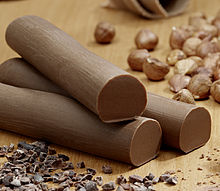
Back غاندوجا Arabic Джандуя Bulgarian Gianduja Catalan Gianduia CEB Gianduia (chocolate) Spanish Gianduja Basque Gianduja French ג'נדויה (שוקולד) HE Gianduja (čokolada) Croatian Ջանդույա Armenian
 Gianduja bars | |
| Type | Chocolate |
|---|---|
| Place of origin | Italy |
| Region or state | Turin, Piedmont |
| Main ingredients | Chocolate paste, hazelnut paste |
Gianduja or gianduia[a] is a homogeneous blend of chocolate with 30% hazelnut paste, invented in Turin during Napoleon's regency (1796–1814). It can be consumed in the form of bars or as a filling for chocolates.
Gianduja is chocolate stretched with hazelnut butter. Similarly to standard chocolate, it is made in both plain and milk versions. It may also contain other nuts, such as almond.[2] As a bar, gianduja resembles normal chocolate, except for the fact that it is significantly softer due to the presence of hazelnut oil,[3] which is liquid at room temperature unlike cocoa butter. However, like conventional chocolate, gianduja is usually tempered.[4]
Chocolate hazelnut spreads are also notably inspired from gianduja. They tend to use, however, other ingredients, typically cocoa powder and vegetable oils rather than cocoa butter-based chocolate.
- ^ "Focus on Gianduia, Part 1.5: Orthography and Pronunciation – DallasFood". dallasfood.org.
- ^ Beckett, Steve T. (2011). "Gianduja chocolate". Industrial Chocolate Manufacture and Use. John Wiley & Sons. ISBN 9781444357554.
- ^ Medrich, Alice (2015). Pure Dessert: True Flavors, Inspiring Ingredients, and Simple Recipes. Artisan Books. p. 157. ISBN 9781579656850.
gianduja resembles a bar of chocolate. It is softer on the tooth than a plain chocolate bar (because of the oil from the hazelnuts)
- ^ Laiskonis, Michael (16 March 2021). "Going Nuts for Gianduja". Institute of Culinary Education. Retrieved 18 March 2024.
Cite error: There are <ref group=lower-alpha> tags or {{efn}} templates on this page, but the references will not show without a {{reflist|group=lower-alpha}} template or {{notelist}} template (see the help page).